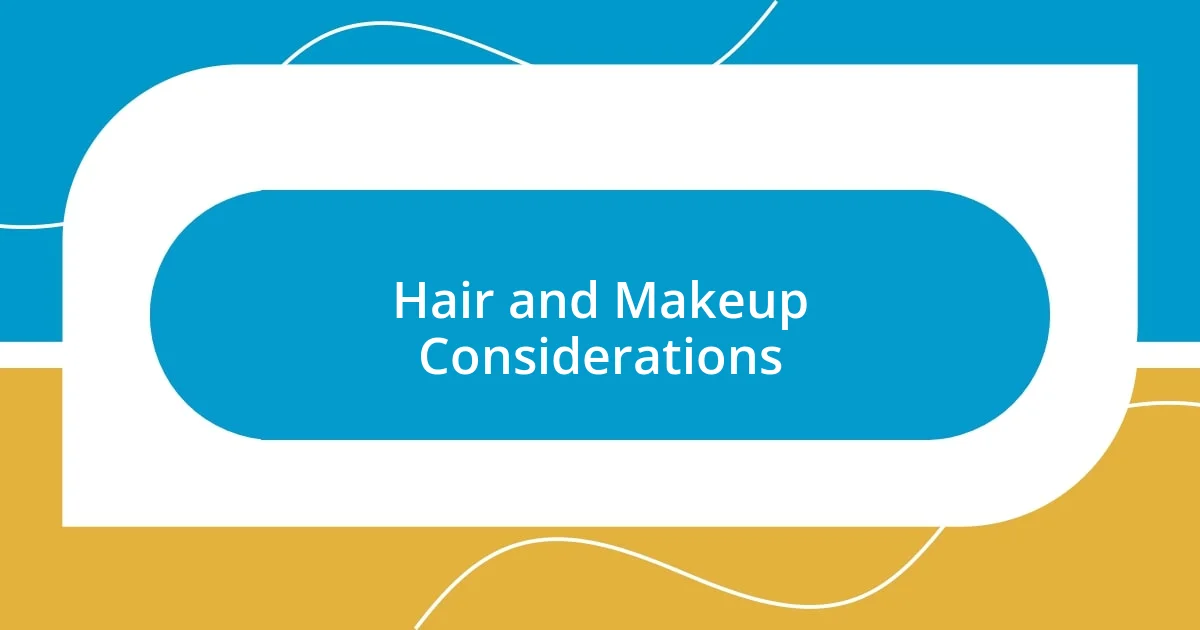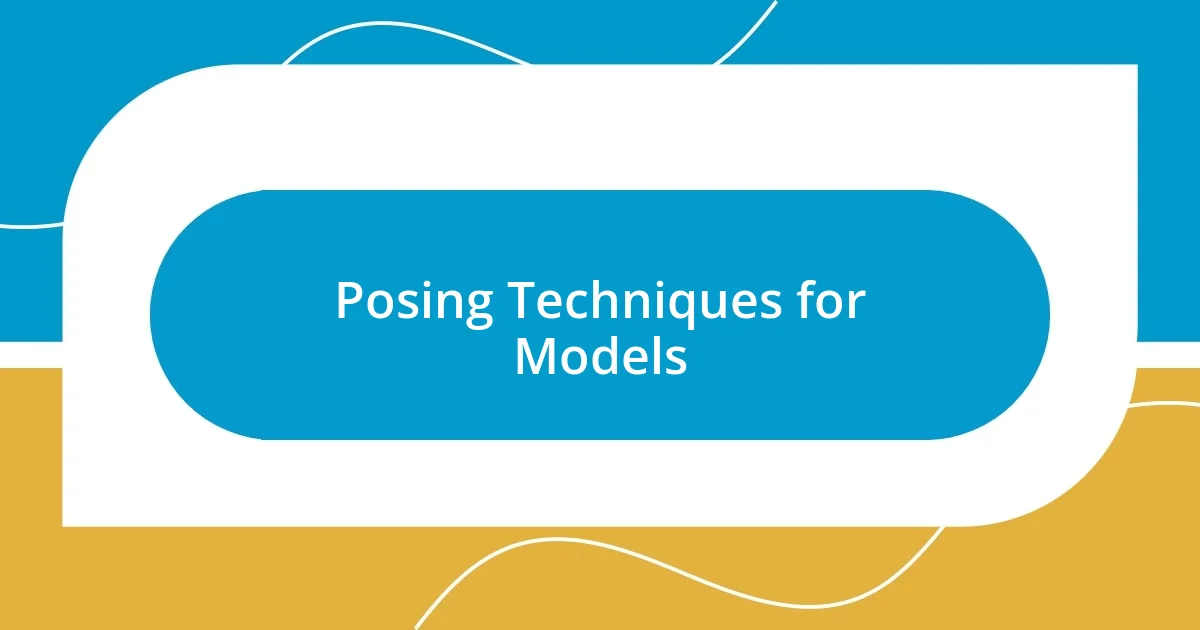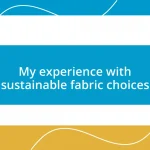Key takeaways:
- Understanding proportions and fabric choice is crucial for effective model styling, enhancing the visual impact of the shoot.
- Building a cohesive color palette using complementary and analogous colors can create emotional connections and enhance a model’s features.
- Connecting with the model and finalizing the look with confidence and attention to detail can significantly elevate the overall quality of the shoot.

Understanding Model Styling Basics
When I first tackled model styling, it struck me how crucial it is to understand proportions. The way a piece flows with a model’s body can truly make or break the overall vibe of a shoot. Have you ever seen a style that just didn’t resonate? That’s often due to a disconnect between design and model presentation.
One lesson I learned early on was the importance of fabric choice. I recall working with a model in a lightweight, drapey fabric that danced beautifully with her movements. The way the material caught the light transformed the shoot entirely! It made me realize how tactile choices can evoke emotion and engage the viewer’s eye more effectively than any post-editing could.
It’s also essential to consider the model’s personality. I remember a particular session where I had to alter my style choices to complement the model’s bold energy. The result was not just a visually striking image, but it also captured her spirit. Ultimately, don’t you think styling is about celebrating each model’s uniqueness while creating a cohesive story?

Choosing the Right Wardrobe Pieces
Choosing the right wardrobe pieces can truly elevate a shoot. I remember a time when I paired a vibrant, patterned dress with a model who had an infectious smile. The way the colors popped against her glowing skin made the images come alive! It was in that moment I realized how a well-selected outfit can not only highlight a model’s features but also create a striking visual story.
When selecting wardrobe pieces, I suggest keeping these key factors in mind:
- Color palette: Consider shades that complement the model’s skin tone and hair color. It makes a huge difference!
- Silhouette: Tailor the cut and shape of clothing to enhance the model’s unique proportions.
- Textures: Mix and match varying materials to create depth and interest.
- Versatility: Choose pieces that can be styled in multiple ways to maximize your shoot’s potential.
- Fit: Ensure everything is tailored perfectly; ill-fitting clothes can distract from the whole look.
Each piece should resonate not just with the model, but also with the intended mood of the shoot. I find that taking these elements into consideration allows for a more harmonious and impactful presentation.

Building a Cohesive Color Palette
Building a cohesive color palette is one of those magical elements in model styling that can either elevate or derail a photoshoot. I still remember my first shoot where I paired a model with a sunset-inspired color scheme: warm oranges, faded yellows, and rich reds. The way those colors bounced off her skin and contrasted with the backdrop was simply mesmerizing! It wasn’t just about aesthetics; it felt like each hue breathed life into the photographs, creating an emotional connection that I cherish even now.
As I continue to work on various projects, I’ve found that understanding color theory can be incredibly helpful in building a palette. For instance, complementary colors—those that are opposite on the color wheel—can create striking visuals that capture attention. In one session, I decided to use a striking blue against a model’s fiery red locks. The result was electric! I realized how a carefully constructed palette could not only enhance features but also convey a certain mood or narrative.
To keep your color selections cohesive, consider starting with a base color and then layer in one or two accent colors that highlight it. Think about analogous colors, which sit next to each other on the color wheel, for a more subtle look. I vividly recall using soft pastels for a serene beach shoot, enhancing the calm vibe while complementing the model’s natural grace. This kind of thoughtful layering allows for visual harmony and resonates with the viewer, making the story being told in the images more impactful.
| Color Theory Concepts | Description |
|---|---|
| Complementary Colors | Colors that are opposite each other on the color wheel, creating striking contrasts. |
| Analogous Colors | Colors that sit next to each other on the color wheel, ideal for a harmonious look. |
| Base Color | The primary color in your palette, around which other colors are built. |
| Accent Colors | Colors used to highlight or emphasize elements within your palette. |

Accessorizing for Maximum Impact
Accessorizing is where the magic truly happens in styling models. I vividly remember a shoot where I decided to add bold statement earrings to an otherwise simple outfit. The transformation was instant! Those earrings not only drew focus to the model’s face but also added a layer of personality that made the images come alive. Isn’t it fascinating how the right accessory can shift the entire narrative of a look?
When I think about maximum impact, I often reflect on the importance of balance. For example, if your model is wearing a patterned top, opting for minimalistic accessories can ensure the look doesn’t compete for attention. I once styled a model in a beautiful, intricate scarf and paired it with understated bracelets. The subtle layering kept her outfit cohesive while allowing that spectacular scarf to take the spotlight. It’s all about making intentional choices that enhance, rather than overwhelm.
I’ve also found that incorporating unexpected pieces can elevate a shoot significantly. During one memorable session, I introduced a quirky vintage hat to a refined, elegant outfit. The combination was unconventional, yet the contrast created an intriguing visual story that resonated with viewers. Have you ever tried mixing styles like that? It’s a powerful reminder that sometimes, stepping outside the usual boundaries can lead to stunning results that stick with your audience long after they’ve seen the images.

Hair and Makeup Considerations
When it comes to hair and makeup, I’ve learned that these elements can dramatically change a model’s presence in front of the camera. I still remember a particular shoot where the decision to go with a sleek, high ponytail made all the difference. The model’s strong features were accentuated beautifully, creating an athletic vibe that played perfectly with the edgy outfit. Have you ever noticed how a simple hairstyle can shift the entire mood of a photoshoot?
Makeup is another crucial layer in the styling process. I often think about the balance between bold and natural looks. There was a time I opted for a vibrant red lip paired with a more understated eye for a vintage-inspired shoot. The combination was daring yet classic, and it told a story of confidence and sophistication. It’s fascinating how colors and techniques can evoke emotions—do you have a go-to makeup trick that instantly enhances your model’s character?
I advise considering the model’s skin tone and features when choosing hair and makeup. In one memorable project, I styled a model with rich, warm undertones; a gold shimmer on her eyelids brought out her natural glow, creating a stunning effect. It was a reminder that thoughtful choices can lead to breathtaking results. Ultimately, hair and makeup are not just about looking good; they can convey emotions and add depth to the narrative of the shoot.

Posing Techniques for Models
Posing techniques are pivotal in shaping the story conveyed through a model’s shoot. I recall an experience when I encouraged a model to lean slightly forward, creating an engaging and inviting posture. This small adjustment not only made her look more approachable but also added energy to the images. Have you ever noticed how angles can completely change the vibe of a photograph?
I find that creating shapes with the body can enhance the visual interest of a shot. For instance, in one session, I guided a model to create soft curves with her arms and legs, which imparted a sense of elegance that complemented her flowing dress. This technique can transform a static pose into something dynamic and fluid. Isn’t it amazing how a few simple shifts can breathe life into a scene?
Moreover, I believe in the power of connecting with the model on a personal level to unlock their natural charisma. During a recent shoot, I discovered that sharing an inspiring story—or even a silly joke—immediately loosened up the atmosphere. The result was a series of candid poses that radiated authenticity and joy. Have you ever tried incorporating a light-hearted element to help your model shine? In my experience, that genuine connection can lead to striking images that resonate deeply with viewers.

Finalizing the Look with Confidence
Finalizing a model’s look is where all the elements I’ve painstakingly curated come together. I distinctly remember a high-fashion shoot where, after adjusting her outfit and refining the hair and makeup, I felt this surge of excitement. The moment I saw the model in that final look, I felt assured that the vibe was spot on. It’s in that moment of clarity when you know you’ve hit the mark—have you ever experienced that rush of satisfaction when everything aligns just right?
Confidence plays a huge role in how a model presents themselves, and I often remind myself that it’s not just about the clothing; it’s how the model carries it. I was once on set with a model who initially felt unsure about an avant-garde outfit. Once we pumped up the music and infused some energy into the atmosphere, she transformed completely. It was incredible to see her step into that confidence, fully owning the look, and it truly enhanced the shoot. Do you have a go-to strategy that helps boost your model’s confidence in front of the camera?
Finally, I always advocate for a ‘final check’ before we wrap things up. I make it a ritual to step back and assess the overall look. One time, I caught a small detail that had slipped by—a strap that wasn’t sitting right. Adjusting it not only refined the look but also solidified that feeling of complete confidence in our execution. It’s those tiny details that can elevate a shoot from great to unforgettable. How do you ensure that all the finishing touches are in place before calling it a wrap?














